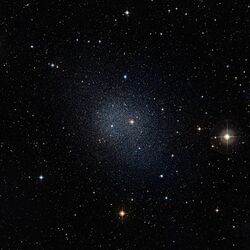Astronomy:Lambda2 Fornacis
| Observation data Equinox J2000.0]] (ICRS) | |
|---|---|
| Constellation | Fornax |
| Right ascension | 02h 36m 58.6079s[1] |
| Declination | −34° 34′ 40.714″[1] |
| Apparent magnitude (V) | 5.78[2] |
| Characteristics | |
| Spectral type | G1V[3] |
| B−V color index | +0.653±0.005[2] |
| Astrometry | |
| Radial velocity (Rv) | +11.80±0.65[2] km/s |
| Proper motion (μ) | RA: −18.507±0.065[1] mas/yr Dec.: −258.869±0.089[1] mas/yr |
| Parallax (π) | 39.3512 ± 0.0543[1] mas |
| Distance | 82.9 ± 0.1 ly (25.41 ± 0.04 pc) |
| Absolute magnitude (MV) | 3.74±0.04[4] |
| Details | |
| A | |
| Mass | 1.18±0.04[4] M☉ |
| Radius | 1.50±0.05[4] R☉ |
| Luminosity | 3.03[2] L☉ |
| Surface gravity (log g) | 4.12±0.03[4] cgs |
| Temperature | 5,936[4] K |
| Metallicity [Fe/H] | +0.19[4] dex |
| Rotational velocity (v sin i) | 1.4 or 3.2[5] km/s |
| Age | 4.34±0.82[4] Gyr |
| B | |
| Mass | 0.11[6] M☉ |
| Other designations | |
| Database references | |
| SIMBAD | data |
| Exoplanet Archive | data |
| ARICNS | data |
| Extrasolar Planets Encyclopaedia | data |
λ2 Fornacis, Latinized as Lambda2 Fornacis, is the primary of a binary star system in the southern constellation of Fornax. It is just visible to the naked eye as a dim, yellow-hued point of light with an apparent visual magnitude of 5.78.[2] It is located 83 light years distant from the Sun, based on stellar parallax,[1] and is drifting further away with a radial velocity of +12 km/s.[2]
This object is a G-type main-sequence star with a stellar classification of G1V.[3] It is considered a solar analog, being photometrically-similar to the Sun.[8] The star is an estimated 4.3[4] billion years old with 1.2 times the mass of the Sun and 1.5 times the Sun's radius.[4] It is radiating three[2] times the luminosity of the Sun from its photosphere at an effective temperature of 5,936 K.[4] The abundance of elements with more mass than helium is 55% higher than in the Sun.[4][9]
There is a faint co-moving companion star located to the east of the main star at an angular separation of 45″. This is most likely an M5–M6 class red dwarf with 0.11 times the Sun's mass. The projected separation between the pair is about 1,000 astronomical unit|AU.[6]
Planetary system
Precision Doppler spectroscopy from an intensive 48 night observing campaign on the Anglo-Australian Telescope has revealed the presence of a low-mass extrasolar planet orbiting the star. This object has an orbital period of 17.24 days and an eccentricity of 0.2. It has a minimum (baseline) mass of 21.9 M⊕.[10]
| Companion (in order from star) |
Mass | Semimajor axis (AU) |
Orbital period (days) |
Eccentricity | Inclination | Radius |
|---|---|---|---|---|---|---|
| b | ≥0.069±0.007 MJ | 0.14±0.01 | 17.24±0.01 | 0.2±0.09 | — | — |
See also
- List of extrasolar planets
References
- ↑ 1.0 1.1 1.2 1.3 1.4 1.5 Brown, A. G. A. (August 2018). "Gaia Data Release 2: Summary of the contents and survey properties". Astronomy & Astrophysics 616: A1. doi:10.1051/0004-6361/201833051. Bibcode: 2018A&A...616A...1G. Gaia DR2 record for this source at VizieR.
- ↑ 2.0 2.1 2.2 2.3 2.4 2.5 2.6 Anderson, E.; Francis, Ch. (2012). "XHIP: An extended hipparcos compilation". Astronomy Letters 38 (5): 331. doi:10.1134/S1063773712050015. Bibcode: 2012AstL...38..331A.
- ↑ 3.0 3.1 Gray, R. O. et al. (July 2006). "Contributions to the Nearby Stars (NStars) Project: spectroscopy of stars earlier than M0 within 40 pc-The Southern Sample". The Astronomical Journal 132 (1): 161–170. doi:10.1086/504637. Bibcode: 2006AJ....132..161G.
- ↑ 4.00 4.01 4.02 4.03 4.04 4.05 4.06 4.07 4.08 4.09 4.10 da Silva, L. et al. (November 2006). "Basic physical parameters of a selected sample of evolved stars". Astronomy and Astrophysics 458 (2): 609–623. doi:10.1051/0004-6361:20065105. Bibcode: 2006A&A...458..609D.
- ↑ Soto, M. G.; Jenkins, J. S. (July 2018). "Spectroscopic Parameters and atmosphEric ChemIstriEs of Stars (SPECIES). I. Code description and dwarf stars catalogue". Astronomy & Astrophysics 615: 28. doi:10.1051/0004-6361/201731533. A76. Bibcode: 2018A&A...615A..76S.
- ↑ 6.0 6.1 Mugrauer, M. et al. (March 2014). "New wide stellar companions of exoplanet host stars". Monthly Notices of the Royal Astronomical Society 439 (1): 1063–1070. doi:10.1093/mnras/stu044. Bibcode: 2014MNRAS.439.1063M.
- ↑ "lam02 For". SIMBAD. Centre de données astronomiques de Strasbourg. http://simbad.u-strasbg.fr/simbad/sim-basic?Ident=lam02+For.
- ↑ Datson, Juliet et al. (February 2015). "Spectroscopic study of solar twins and analogues". Astronomy & Astrophysics 574: 12. doi:10.1051/0004-6361/201425000. A124. Bibcode: 2015A&A...574A.124D.
- ↑ 10+0.19 = 1.55
- ↑ 10.0 10.1 O’Toole, Simon et al. (2009). "A Neptune-mass Planet Orbiting the Nearby G Dwarf HD16417". The Astrophysical Journal 697 (2): 1263–1268. doi:10.1088/0004-637X/697/2/1263. Bibcode: 2009ApJ...697.1263O.
Coordinates: ![]() 02h 36m 58.6079s, −34° 34′ 40.717″
02h 36m 58.6079s, −34° 34′ 40.717″
 |


